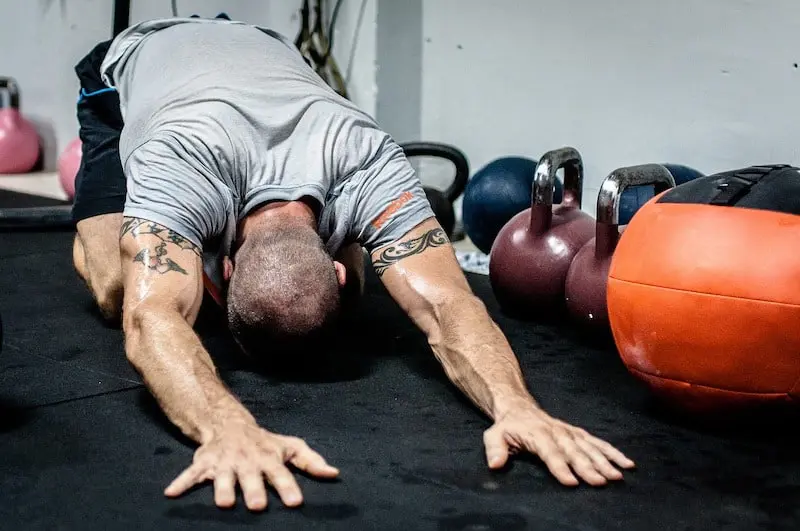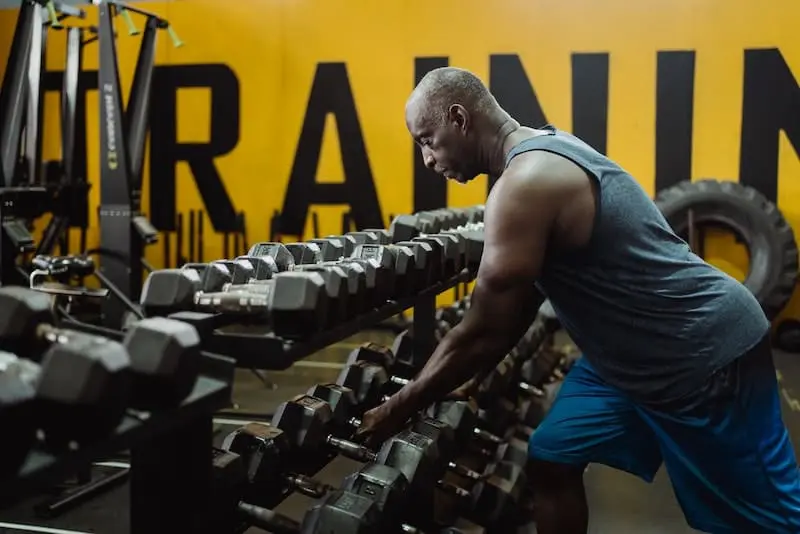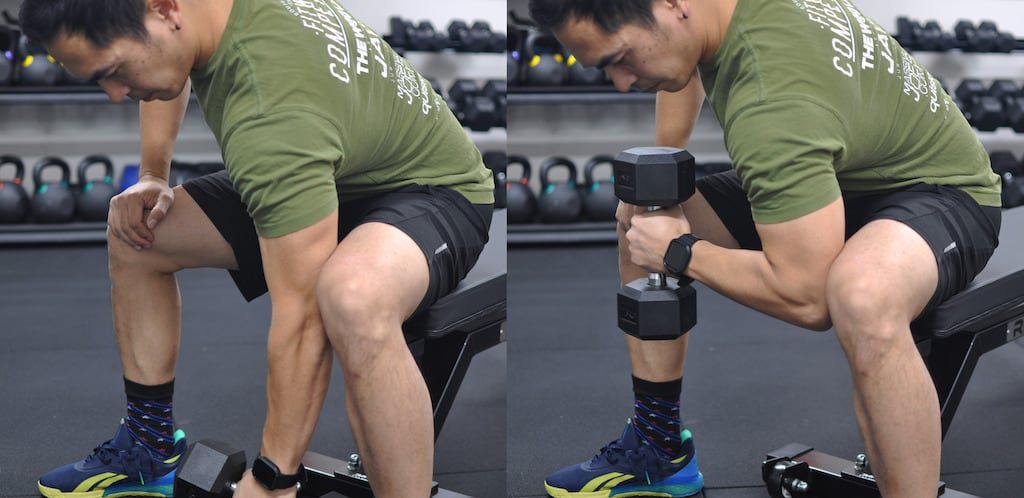
The best online fitness resource you'll ever need. We filter out the BS to ensure you meet your health and fitness goals!

The best online fitness resource you'll ever need. We filter out the BS to ensure you meet your health and fitness goals!

Wanna get strong? Or get big? Or both? If getting stronger is in fact your goal, then this 12 Week Strength Training Program is for you!
Drawing inspiration from my days as a competitive powerlifter, this program is designed specifically to allow you to lift heavier weights than you could ever before. Whether you’re a beginner or a seasoned lifter, you’ll be able to hit personal bests in all your lifts including squats, deadlifts, bench, and more.
Jump to the training program now!
Alternatively, you can download the free PDF using the link below:
| Program style | Resistance training |
| Program duration | 12 weeks |
| Workout duration | 1-2 hours |
| Scheduling | 4 day split |
| Goal | Increase strength |
| Level | Beginners to advanced |
Before we get into the nitty-gritty of the program itself, we need to understand exactly what strength is and why training it is different to traditional bodybuilding routines.
Strength is the ability to withstand force. When we think about resistance training, we think more in terms of how much load can be moved and for how many repetitions of the movement.
Strength differs from “power”. Power is total work (w) divided by time (t) = w/t. Another way to look at strength is Volume Load, which is Load x Reps.
You’re probably one step ahead of me here by thinking that a person who can lift a 5 kg dumbbell 20 times isn’t as “strong” as a buddy who can lift a 20 kg dumbbell 5 times. At some point we’ve got to factor in the total amount a person can lift once, the 1-rep max (1RM).
So, for our purposes here, let’s agree that we’re talking about how much we can make a bar bend and not how many times we can make it go up and down.
Admittedly, there’s something described as “strength density”, which says that there really is a type of strength that’s defined by reps. The example that comes to mind is the friendly competition between the late Fred “Dr. Squat” Hatfield and Mr. Olympia, Tom Platz, was held in 1992 in Essen, Germany.
Hatfield was the first person to squat over 1000 lbs in competition. He squatted in the mid 800s at this event. Platz was known for his freakishly well-developed quads, and he squatted 500lbs for 23 reps. Platz wasn’t able to squat 800 once but nor was Hatfield able to squat 500 for 23 reps. So who’s stronger?
The Hatfield-Platz event was a publicity stunt but it illustrates the point.
The goal of the program you’ll read here is to enable you to “do more weight” for the same number of reps that you’re doing a lesser weight today. Make sense?
Let’s start by trying to dispel confusion about strength and hypertrophy.
It’s widely assumed that one can getting stronger will result in larger muscles, and that those with larger muscles will be stronger. It is unusual to see a small, frail individual who is very strong; however, strong does not equal big and the clinical data demonstrate that.
Turns out that building bigger muscles and gaining strength are two completely different goals. In fact, research shows that size and strength are only loosely associated.
You can get strong without getting big; and you can get big without getting a whole lot stronger.
A recent paper in the exercise literature concluded:
“For males, baseline strength capacity appears to be negatively associated with hypertrophy, and thus stronger males may be less likely to experience the same degree of hypertrophic adaptation over 12 weeks as compared to weaker males.”
To be clear, the paper just cited looked into the effects of progressing reps (more reps over time) without adding load. But it makes the point that getting stronger does not equate to getting bigger…or getting bigger mean you’ll get stronger.
There is some loose overlap for sure. Not trying to start an argument here.
It does shed light on how progressive overload is applied to achieve a strength objective.
Textbook progressive overload can be accomplished by raising either the reps or the weight. When training for strength, your focus should be increasing the weight you lift a given weight with mastery.
Once the weight can be lifted well for a given number of reps, increase the weight (instead of the reps).
Now is the time to assess your training goals. If you’re one of those who believes that getting strong will lead to bigger muscles, check out one of our hypertrophy programs instead. It’s possible to get stronger but also smaller. Strength does not always equal size, necessarily.
Our program exploits progressive overload’s method of increasing load instead of reps.
The workout structure favors load over reps by sequentially reducing target rep ranges as you progress through three of four-week micro-cycles. Reps will go down as the weight goes up.
Reducing the rep ranges favors incremental strength increases and structures the program more like a traditional strength competition program.
It’s a slightly modified version of the program I used to train for the Texas State Open powerlifting competition more years ago than I care to admit.
I was taught this protocol by the elite US powerlifters I was fortunate to train with. It’s the routine they used with a couple of tweaks.
| Day | Split |
|---|---|
| 1 | Posterior Chain / Deadlift |
| 2 | Chest, Shoulders, Triceps |
| 3 | Rest |
| 4 | Legs |
| 5 | Auxiliary Day |
| 6 | Rest |
| 7 | Rest |
Here’s the way a typical week unfolded:
Day 1 was Monday, deadlift day. I’ve tweaked Deadlift day a bit into a “posterior chain” day that addresses the glutes, hams, adductors, and back a little more generally.
The competition deadlift is–believe it or not–a technically challenging lift, so much so that I’ve replaced it here with the Romanian Deadlift (RDL).
The RDL delivers the same strength results and is very similar in form to the competition deadlift when done correctly.
The competition deadlift requires lift speed through the “sticking point” which is just at or above the knee. Many blame this on the inconvenient location of the knee as the bar passes by it.
In reality though, what makes it tough is that the central nervous system is shifting gears between lower body muscle groups, and if the lifter hasn’t generated sufficient momentum to pass through that sticking point, well, they get stuck and the lift is a fail. (There’s usually a lot of really shitty form, hitching, and shaking that accompanies getting stuck).
They also taught me a cool training variation of the deadlift call a “halting”, which is short for a “halted” deadlift. The Halting is one way to train the sticking point.
For me, “halting” deadlifts were responsible for a lot of gains. “Haltings” are deadlift reps where you don’t lock out at the top and the weight never touches the ground from the time you pick it up. You rep between a couple inches off the floor to above the knee. So, a typical set would be reps in the middle of the DL range of motion. Shin-level to mid-thigh.
Because there’s no lock-out and no setting down of the weight, the lifter is forced to keep the weight moving without rest for the entire set. They are extremely challenging especially because they must be done with perfect form to avoid injury.
Rack pulls figured heavily (no pun intended) into that routine I used back when, and they work. Train them from a pin height just below the sticking point. We actually did those on squat day, but in hindsight, I’m not sure it matters too much other than spreading the workload. *If you’d like to move rack pulls to Leg Day instead of Posterior Chain/Deadlift day, go for it. Keep an eye on recovery though and adjust as needed.
Tuesday was bench day. For this program, you can substitute a good chest press machine instead. The same training principles apply, and if you’re fortunate enough to train in a gym with an excellently designed chest press machine (e.g. converging handles and good back support), you can also expect to develop some nice pecs and anterior delts in the process.
We always tossed in some hammer curls and triceps pushdowns on bench day. They make sense to train on chest day.
We did not do shoulder presses. I’ve added them to round out the strength routine. For anyone who was training for a powerlifting competition though, I wouldn’t include shoulder presses. It’s too much work and would be difficult to recover from week-to-week prior to competition date.
We took Wednesday off.
Thursday was the dreaded squat day. For our purposes here, this routine treats Squat Day as Leg Day and squats have been replaced with leg press. The best conventional wisdom these days is that you’ll develop the targeted area better if the body is in a stable position. The squat is necessary if you’re powerlifting but it’s not if you just want to gain strength.
Friday was auxiliary day. That was for the lighter support muscle work, with higher reps and lighter weights. I loved auxiliary days (partly because they were Fridays and Fridays are pretty awesome anyway.)
Days 6 and 7 are rest days.
| POSTERIOR CHAIN | Warm up | Set 1 | Set 2 | Set 3 | Set 4 |
| Air squats | 50 | ||||
| Romanian Deadlift (RDL) | 20 | 10-12 | 10-12 | 10-12 | 10-12 |
| “Halting” RDLs | 10-12 | 10-12 | |||
| Rack pulls | 10-12 | 10-12 | 10-12 | 10-12 | |
| DB or Hex Bar VMO Squats | 20 | 10-12 | 10-12 | 10-12 | |
| Lat Pull-Downs or Pull-ups | 20 | 10-12 | 10-12 | 10-12 | |
| Shrugs, Kelso Shrugs preferred | 10-12 | 10-12 | 10-12 |
| CHEST / SHOULDERS / ARMS | Warm up | Set 1 | Set 2 | Set 3 | Set 4 |
| Machine Chest or BB Bench Press | 20 | 10-12 | 10-12 | 10-12 | 10-12 |
| Seated Smith Machine DB Press, Utility or Adjustable Bench | 20 | 10-12 | 10-12 | 10-12 | 10-12 |
| Biceps Curls Cable, DB, or BB (Gironda style) | 20 | 10-12 | 10-12 | 10-12 | 10-12 |
| Triceps extensions Cable, DB, or EZ Curl | 20 | 10-12 | 10-12 | 10-12 | 10-12 |
| LEGS | Warm up | Set 1 | Set 2 | Set 3 | Set 4 |
| Leg Press | 20 | 10-12 | 10-12 | 10-12 | 10-12 |
| RFE Split Squats (Bulgarian Split Squats) | 10-12 | 10-12 | 10-12 | 10-12 | |
| Leg Extensions | 20 | 15-20 | 12-15 | 12-15 | |
| Leg Curls | 20 | 15-20 | 12-15 | 12-15 |
| AUXILIARY | Warm up | Set 1 | Set 2 | Set 3 |
| DB Flat Bench | 20 | 15-20 | 12-15 | 12-15 |
| DB Lu, “Y” Raises, or Plate Raises | 20 | 15-20 | 12-15 | 12-15 |
| Lat Pull-Downs or Pull-ups | 20 | 15-20 | 12-15 | 12-15 |
| Hammer Curls | 20 | 15-20 | 12-15 | 12-15 |
| Triceps extensions Cable, DB, or EZ Curl | 20 | 15-20 | 12-15 | 12-15 |
| POSTERIOR CHAIN | Warm up | Set 1 | Set 2 | Set 3 | Set 4 |
| Air squats | 50 | ||||
| Romanian Deadlift (RDL) | 20 | 8-10 | 8-10 | 8-10 | 8-10 |
| “Halting” RDLs | 8-10 | 8-10 | |||
| Rack pulls | 8-10 | 8-10 | 8-10 | 8-10 | |
| DB or Hex Bar VMO Squats | 20 | 8-10 | 8-10 | 8-10 | |
| Lat Pull-Downs or Pull-ups | 20 | 8-10 | 8-10 | 8-10 | |
| Shrugs, Kelso Shrugs preferred | 8-10 | 8-10 | 8-10 |
| CHEST / SHOULDERS / ARMS | Warm up | Set 1 | Set 2 | Set 3 | Set 4 |
| Machine Chest or BB Bench Press | 20 | 8-10 | 8-10 | 8-10 | 8-10 |
| Seated Smith Machine DB Press, Utility or Adjustable Bench | 20 | 8-10 | 8-10 | 8-10 | 8-10 |
| Biceps Curls Cable, DB, or BB (Gironda style) | 20 | 8-10 | 8-10 | 8-10 | 8-10 |
| Triceps extensions Cable, DB, or EZ Curl | 20 | 8-10 | 8-10 | 8-10 | 8-10 |
| LEGS | Warm up | Set 1 | Set 2 | Set 3 | Set 4 |
| Leg Press | 20 | 8-10 | 8-10 | 8-10 | 8-10 |
| RFE Split Squats (Bulgarian Split Squats) | 8-10 | 8-10 | 8-10 | 8-10 | |
| Leg Extensions | 20 | 12-15 | 10-12 | 10-12 | |
| Leg Curls | 20 | 12-15 | 10-12 | 10-12 |
| AUXILIARY | Warm up | Set 1 | Set 2 | Set 3 |
| DB Flat Bench | 20 | 12-15 | 10-12 | 10-12 |
| DB Lu, “Y” Raises, or Plate Raises | 20 | 12-15 | 10-12 | 10-12 |
| Lat Pull-Downs or Pull-ups | 20 | 12-15 | 10-12 | 10-12 |
| Hammer Curls | 20 | 12-15 | 10-12 | 10-12 |
| Triceps extensions Cable, DB, or EZ Curl | 20 | 12-15 | 10-12 | 10-12 |
| POSTERIOR CHAIN | Warm up | Set 1 | Set 2 | Set 3 | Set 4 |
| Air squats | 50 | ||||
| Romanian Deadlift (RDL) | 20 | 6-8 | 6-8 | 6-8 | 6-8 |
| “Halting” RDLs | 6-8 | 6-8 | |||
| Rack pulls | 6-8 | 6-8 | 6-8 | 6-8 | |
| DB or Hex Bar VMO Squats | 20 | 6-8 | 6-8 | 6-8 | |
| Lat Pull-Downs or Pull-ups | 20 | 6-8 | 6-8 | 6-8 | |
| Shrugs, Kelso Shrugs preferred | 6-8 | 6-8 | 6-8 |
| CHEST / SHOULDERS / ARMS | Warm up | Set 1 | Set 2 | Set 3 | Set 4 |
| Machine Chest or BB Bench Press | 20 | 6-8 | 6-8 | 6-8 | 6-8 |
| Seated Smith Machine DB Press, Utility or Adjustable Bench | 20 | 6-8 | 6-8 | 6-8 | 6-8 |
| Biceps Curls Cable, DB, or BB (Gironda style) | 20 | 6-8 | 6-8 | 6-8 | 6-8 |
| Triceps extensions Cable, DB, or EZ Curl | 20 | 6-8 | 6-8 | 6-8 | 6-8 |
| LEGS | Warm up | Set 1 | Set 2 | Set 3 | Set 4 |
| Leg Press | 20 | 6-8 | 6-8 | 6-8 | 6-8 |
| RFE Split Squats (Bulgarian Split Squats) | 6-8 | 6-8 | 6-8 | 6-8 | |
| Leg Extensions | 20 | 10-12 | 8-10 | 8-10 | |
| Leg Curls | 20 | 10-12 | 8-10 | 8-10 |
| AUXILIARY | Warm up | Set 1 | Set 2 | Set 3 |
| DB Flat Bench | 20 | 10-12 | 8-10 | 8-10 |
| DB Lu, “Y” Raises, or Plate Raises | 20 | 10-12 | 8-10 | 8-10 |
| Lat Pull-Downs or Pull-ups | 20 | 10-12 | 8-10 | 8-10 |
| Hammer Curls | 20 | 10-12 | 8-10 | 8-10 |
| Triceps extensions Cable, DB, or EZ Curl | 20 | 10-12 | 8-10 | 8-10 |

Warm up before your workout to prevent injury and practice the movements. Warm-ups are important for anyone and even more crucial for older adults. If you’re a newcomer to the gym but a veteran in another sport, you’ll already understand the value of a good warm-up.
The warm-ups included in this workout program are composed of very light sets of the movements you’ll be doing during the workout, an application of the SAID Principle (Specific Adaptation to Imposed Demands).
You should also get in the habit of stretching the target muscles before actually targeting them. This program will target basically every single muscle you have in your body, so getting those muscle loose is crucial.
There’s nothing worse than getting started on a heavy set of bench press and pulling a pectoral muscle, which could have easily been prevented with some simple chest stretches.

As with almost all resistance exercise programs, progressive overload applies. Your goal should be to:
The program diminishes the rep count as you progress through it, with the idea being that by the final four weeks, almost all the reps will be moving slowly and challenging you.
If you’re selecting weights you can perform masterful reps with, and follow the rep ranges, two things should be happening:
The last reps of each set should be the ones that are producing your strength gains.
The weight you lift in Week 12 for 6 reps should be more than you could lift for 6 reps in Week 4.

Strength requires applying force to do work, in our case, to move a weight. Naturally, the heavier the resistance becomes in relation to the force being applied, the slower it’s going to move.
Use a rhythmic cadence for your reps, lowering slowly and under control on the eccentric phase and then exploding against them for the concentric.
To the casual observer, your reps are going to look pretty slow, but to you, you’re going to feel like you’re pressing as hard as you possibly can on those final reps of each set.
This is not the same thing as tempo training where you intentionally slow the reps down. Speed should be governed by how heavy the weight is versus the force you’re applying.
You do not want to use momentum to move the weight. If just gaining raw strength is your goal, you want the muscles doing the work and not simply physics.

This is as good a time as any to share a pro tip about deadlifts for reps.
Ever been in a gym and there’s the dude (maybe you) who sets the weight down between “reps”, then regrips the bar and goes again.
That guy’s doing a set of singles.There is a big difference between sets of singles and a repped set of deadlifts.
There are reasons to train both.
A set of deadlift reps is when the bar comes off the floor and the lifter maintains tension on the bar for the entire number of repetitions in the set without setting it down. If the weights bang the floor, that ain’t a set of reps. The plates should do nothing greater than kiss the floor before the next rep.
Repping deadlifts in this way maintains the tension on your muscles for the entire duration of the set. And if you were happen to be training for muscular hypertrophy, this is how you should rep deadlifts for that purpose. Setting them down for even a second defeats the purpose and abbreviates total time under tension.
Training sets of reps is how you should train most of the time. Sets of singles are reserved for pre-competition as you prep for a lifting meet.
There’s a place for training sets of singles. A set of singles is a series of individual deadlifts where the weight comes to a rest on the platform, even for a second.
The lifter lets the bar come to a stop without releasing their grip, repositions and starts another lift. A second or two might pass between these “reps”.
Training sets of singles can be important to practice getting set up and pulling the weight in the most fluid and efficient manner possible.
If you were prepping for a lifting tournament, you might train sets of singles beginning three to four weeks out from competition date.
If you’re training as hard as you should during this routine, you will need every rest day. Stay away from the gym.
If you feel like going for a long walk or a bike ride in nature, fine; do that. But stay away from the gym.
If you’re leaving the gym fresh as a daisy after any of these workouts, then don’t expect to be gaining much strength. You don’t need to assassinate yourself either.
Your rest periods between sets and exercises should be long enough between sets for you to be able to do the next set with equal or more intensity.
If you feel you need a target rest period time, use three minutes. It’s been demonstrated that a longer interset rest period of three minutes produced greater strength and size gains as opposed to a shorter interval of just one minute.
What’s important is that you’re going all out (and using great form) on every rep and every set.
Oh, and leave your smart phone in your bag or locker. I promise: there are no strength gains to be had by checking your text messages.
Download our 12 Week Strength Training Program PDF using the link below: